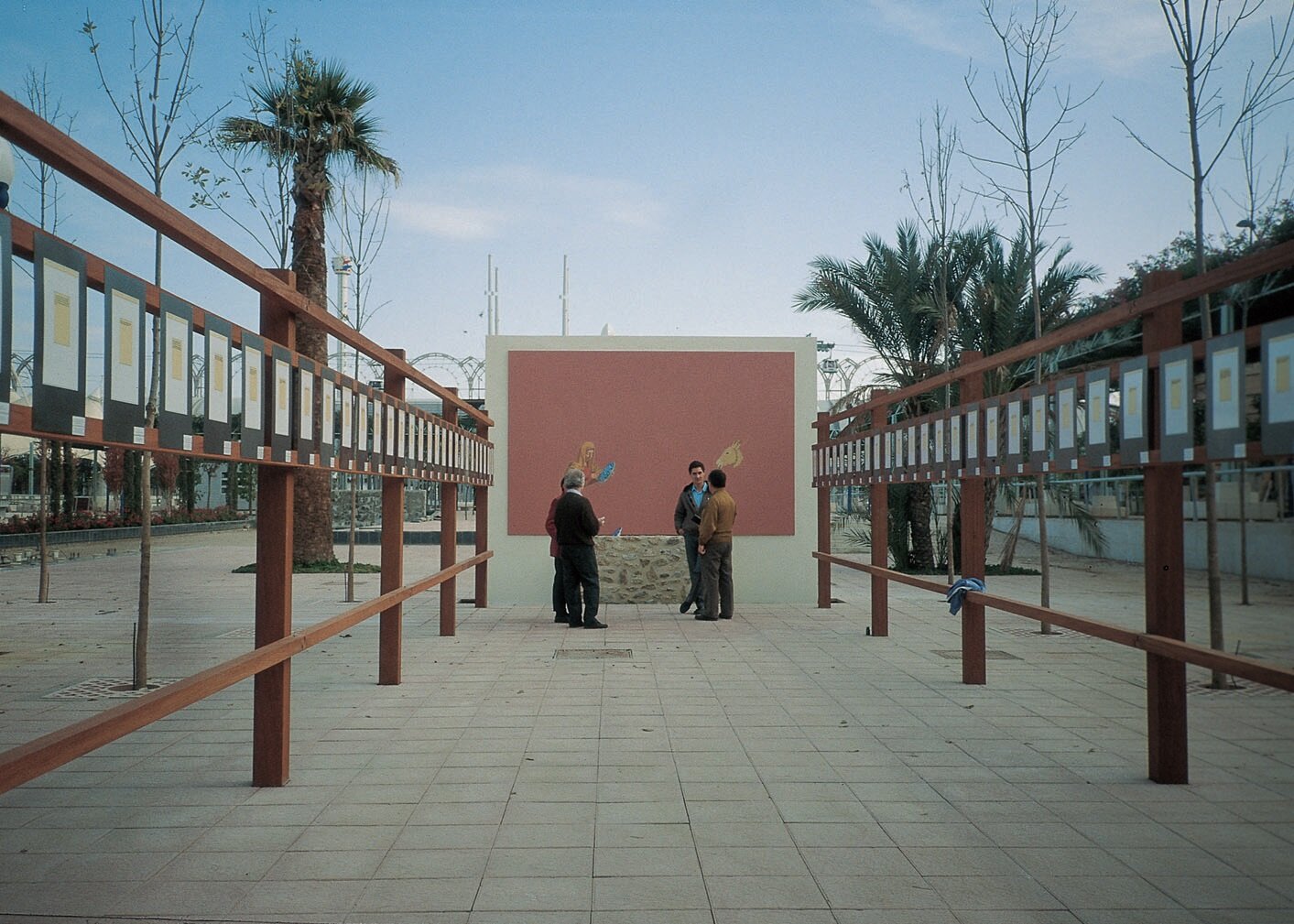The Blue Dish
YEAR: 1992
CATALOGUE NUMBER: 61
PROVENANCE
The artist
1992, Collection City of Seville
EXHIBITIONS
Seville
Expo 92, 21 Sep 1992 — 12 Oct 1992
DESCRIPTION
The installation The Blue Dish is a unique kind of attraction, a provocation for the viewers, a unique game-riddle ‘of opinions’: who will find the correct answer, who will turn out to be right? The installation is arranged amidst other pavilions and can be understood in many ways: both seriously and as a funny joke, as a mockery of contemporary art. The length of the installation is 21.42 meters, its width is 4.5 meters, its height is 3.68 meters. It is made of wood, metal, stone, and ceramic.
The installation The Blue Dish consists of a long wooden structure forming a corridor. Arranged at the end of this corridor is a large painting attached to a stone wall. The subject of this painting is represented in two fragments: a figure of a woman with a blue dish in her hands, and a fragment of the head of a mule. The rest, apparently, was not preserved, and it was painted over with dark red-brown paint. In front of the painting is a short stone pedestal to which is inserted from above the very same ‘blue dish’ that is depicted in the painting.
Along the entire length of the wooden structure on both sides hang 86 metal plaques with texts on them. These are utterances by viewers regarding this painting. The meanings of the utterances are very diverse: from the banal and funny to the profound and philosophical. The visitor to this installation moves along this ‘corridor of opinions’ toward the painting, reads the texts and exits in the interval between the structure and the painting.
Having read these commentaries uttered before him, the visitor understands that each person is right in his own way, although he can select the ‘most correct’ one in accordance with his own tastes. The content of the commentaries changes as the visitor moves closer to the painting. The closer the viewer gets, the more and more new details he sees on it, and consequently reacts to them.
The choice of this installation with this subject was conditioned by the place where it is built – next to an open theater and where the main visitors will be the viewers leaving the theater during intermission. Having seen that you can look at one and the same thing from various positions, it might just occur to them to look at the show they are watching the same way.
The dimensions of the painting The Blue Dish are 390 x 250 cm. It is painted on a wooden board 6 cm in width with oil enamel and built into a stone wall to a depth of 2 cm at a height of 97 cm above the ground. The wall on which it is attached is made of construction stone and is covered with coarse whitewash. The length of the stone wall is 450 cm, its height is 367 cm, its width is 42 cm.
The Pedestal in Front of the Painting
The pedestal is placed flush against the stone wall, arranged in the center of it and 1 cm lower than the painting attached to it. The pedestal is made out of white construction stone and is not whitewashed. The real ‘blue dish’ is partially cemented into its upper surface (it is also attach ed from behind with cement to prevent it from be – ing damaged). The upper surface is smooth. The pedestal is 96 cm high, 205 cm long, and 38 cm wide.
The Wooden Structure
The wooden structure consists of two ‘walls’ standing parallel to one another at a distance of 420 cm and made of 4 rows of wooden unfinished (construction) beams that are 7 x 7 cm. (More precisely: these are the kind of beams used as support beams at construction sites.) The beams are attached in 4 parallel rows (see diagram) on 7 columns that are 10 x 10 cm. The height of the upper row of beams is 237 cm, the height of the columns is 250 cm.
The Plaques with Commentaries
Metal plaques are hung in a single row on the wooden structure at the height of an average person. The plaques are 0.5 cm in width, and each one is 51.5 x 35 cm. The texts of the commentaries are written ‘by hand,’ printed on special plastic and glued to the metal plaques. All of this is very resistant to humidity and can be preserved for a long time.
Images
Literature






